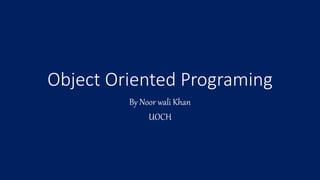OOP lecture 04
•Transferir como PPTX, PDF•
0 gostou•54 visualizações
Classes In OOP
Denunciar
Compartilhar
Denunciar
Compartilhar

Recomendados
Recomendados
Mais conteúdo relacionado
Mais procurados
Mais procurados (11)
Introduction to Object Oriented Programming Class IX

Introduction to Object Oriented Programming Class IX
Semelhante a OOP lecture 04
Semelhante a OOP lecture 04 (20)
Session 3 - Object oriented programming with Objective-C (part 1)

Session 3 - Object oriented programming with Objective-C (part 1)
Mais de University of Chitral
Mais de University of Chitral (15)
Último
https://app.box.com/s/7hlvjxjalkrik7fb082xx3jk7xd7liz3TỔNG ÔN TẬP THI VÀO LỚP 10 MÔN TIẾNG ANH NĂM HỌC 2023 - 2024 CÓ ĐÁP ÁN (NGỮ Â...

TỔNG ÔN TẬP THI VÀO LỚP 10 MÔN TIẾNG ANH NĂM HỌC 2023 - 2024 CÓ ĐÁP ÁN (NGỮ Â...Nguyen Thanh Tu Collection
Making communications land - Are they received and understood as intended? webinar
Thursday 2 May 2024
A joint webinar created by the APM Enabling Change and APM People Interest Networks, this is the third of our three part series on Making Communications Land.
presented by
Ian Cribbes, Director, IMC&T Ltd
@cribbesheet
The link to the write up page and resources of this webinar:
https://www.apm.org.uk/news/making-communications-land-are-they-received-and-understood-as-intended-webinar/
Content description:
How do we ensure that what we have communicated was received and understood as we intended and how do we course correct if it has not.Making communications land - Are they received and understood as intended? we...

Making communications land - Are they received and understood as intended? we...Association for Project Management
Último (20)
ICT role in 21st century education and it's challenges.

ICT role in 21st century education and it's challenges.
Micro-Scholarship, What it is, How can it help me.pdf

Micro-Scholarship, What it is, How can it help me.pdf
TỔNG ÔN TẬP THI VÀO LỚP 10 MÔN TIẾNG ANH NĂM HỌC 2023 - 2024 CÓ ĐÁP ÁN (NGỮ Â...

TỔNG ÔN TẬP THI VÀO LỚP 10 MÔN TIẾNG ANH NĂM HỌC 2023 - 2024 CÓ ĐÁP ÁN (NGỮ Â...
General Principles of Intellectual Property: Concepts of Intellectual Proper...

General Principles of Intellectual Property: Concepts of Intellectual Proper...
ICT Role in 21st Century Education & its Challenges.pptx

ICT Role in 21st Century Education & its Challenges.pptx
Python Notes for mca i year students osmania university.docx

Python Notes for mca i year students osmania university.docx
Food safety_Challenges food safety laboratories_.pdf

Food safety_Challenges food safety laboratories_.pdf
Making communications land - Are they received and understood as intended? we...

Making communications land - Are they received and understood as intended? we...
Salient Features of India constitution especially power and functions

Salient Features of India constitution especially power and functions
Interdisciplinary_Insights_Data_Collection_Methods.pptx

Interdisciplinary_Insights_Data_Collection_Methods.pptx
This PowerPoint helps students to consider the concept of infinity.

This PowerPoint helps students to consider the concept of infinity.
OOP lecture 04
- 1. Object Oriented Programing By Noor wali Khan UOCH
- 2. Class • In an OOP model, some of the objects exhibit identical characteristics (information structure and behavior) • We say that they belongs to same class. • In object-oriented programming, a class is a blueprint for creating objects (a particular data structure), providing initial values for state (member variables or attributes), and implementations of behavior (member functions or methods). • The class is a blueprint that defines a nature of a future object.
- 3. Class • An instance is a specific object created from a particular class. Classes are used to create and manage new objects and support inheritance—a key ingredient in object-oriented programming and a mechanism of reusing code. • A class is a way of organizing information about a type of data so a programmer can reuse elements when making multiple instances of that data type—for example, if a programmer wanted to make three instances of Car, maybe a BMW, a Ferrari, and a Ford instance. • The Car class would allow the programmer to store similar information that is unique to each car (they are different models, and maybe different colors, etc.) and associate the appropriate information with each car.
- 6. Inheritance • The capability of a class to derive properties and characteristics from another class is called Inheritance. • Inheritance is one of the most important feature of Object Oriented Programming. Sub Class: • The class that inherits properties from another class is called Sub class or Derived Class. • Super Class: • The class whose properties are inherited by sub class is called Base Class or Super class
- 7. Why and when to use inheritance? • Consider a group of vehicles. You need to create classes for Bus, Car and Truck. • The methods fuelAmount(), capacity(), applyBrakes() will be same for all of the three classes. • If we create these classes avoiding inheritance then we have to write all of these functions in each of the three classes as shown in figure (next slide)
- 8. Inheritance : Example You can clearly see that above process results in duplication of same code 3 times.
- 9. Inheritance • This increases the chances of error and data redundancy. • To avoid this type of situation, inheritance is used. • If we create a class Vehicle and write these three functions in it and inherit the rest of the classes from the vehicle class, then we can simply avoid the duplication of data and increase re-usability.
- 10. Inheritance • Look at the below diagram in which the three classes are inherited from vehicle class:
